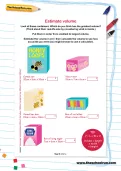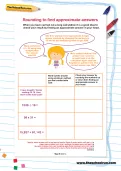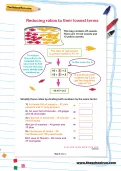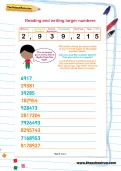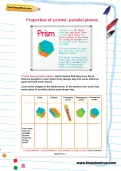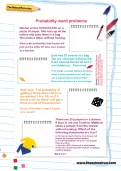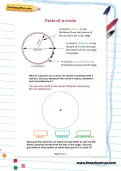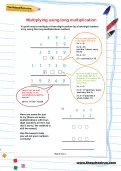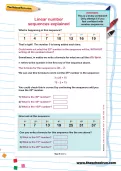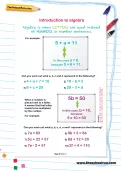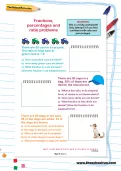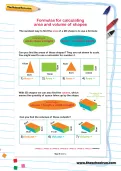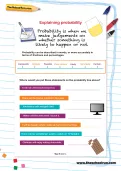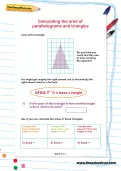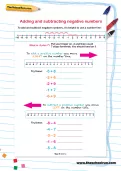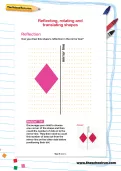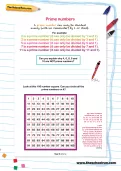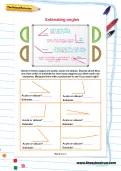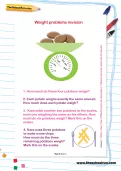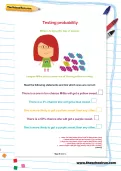Year 6 Maths worksheets
Free worksheets: Weights and measurements, KS2, Y6
You’ll need to login or Register first to access these worksheets for free.
Once you’ve tried out our free worksheets, why not explore all our resources (1000s of worksheets, interactive tutorials, learning packs and more) with a 14-day FREE trial subscription.
Calculating perimeters
A Year 5 and 6 printable worksheet created by an experienced teacher to help your child practise calculating perimeters.
To find the perimeter of a shape you must add up the lengths of each of the sides. Can your child calculate the perimeters of these common shapes?
To find the perimeter of a shape you must add up the lengths of each of the sides. Can your child calculate the perimeters of these common shapes?
Estimate volume
Look at these containers. Which do you think has the greatest volume? (Think about their real-life size by considering what is inside.) Put them in order from smallest to largest volume. Estimate the volume in cm3, then calculate the volume to see how accurate you were.
Rounding to find approximate answers
When you have carried out a long calculation it is a good idea to check your result by finding an approximate answer in your head. Work out the answers to these questions using whatever method you feel comfortable with. Then check your answer by rounding the numbers up or down then finding an approximate answer in your head.
Reducing ratios to their lowest terms
To reduce a ratio to its simplest form, you need to find a factor that you could divide both numbers by. Simplify these ratios by dividing both numbers by the same factor.
Reading and writing larger numbers
This table shows the place value of each of the digits of the large number above. Can you say the number above? Can you write it in words? Look at these numbers and put
the commas in where you think they should go. Say them out loud and then write them in words.
the commas in where you think they should go. Say them out loud and then write them in words.
Properties of prisms: parallel planes
A prism is a 3D shape with two identical ends and all flat sides. Its cross section is the same all along its length and always the same shape as its ends. The shape of the prism’s ends gives the prism its name (for example, the ends of a hexagonal prism are hexagons). Prisms have parallel planes, which means that they have faces that are parallel to each other (they always stay the same distance apart and will never meet).
Probability word problems
Can you answer these tricky probability word problems? Pencil at the ready...
Parts of a circle
Here is a picture of a circle. Its centre is marked with a red dot. Can you measure the circle’s radius, diameter and circumference?
Multiplying using long multiplication
A quick way to multiply a three-digit number by a two-digit number is by using the long multiplication method. Here are some for you to try (there are some multiplications with four-digit numbers in here, but don’t worry, the method is still the same!). Use the boxes to help you set out your numbers correctly!
Multiplying fractions
When multiplying two fractions together, you quite simply multiply the numerators and then multiply the denominators. Work out the answers to these number sentences by multiplying both the numerators together and both the denominators together. Shade the diagram to show that you have found a fraction of a fraction.
Linear number sequences explained
A tricky worksheet on number sequences and writing formulas for the nth term.
Introduction to algebra
Use this teacher-created, Year 6 resource to help your child understand what algebra is and practise solving algebra questions.
Fractions, percentages and ratio problems
Can you work out these tricky fractions, percentages and ratio problems? Ready, set...
Formulas for calculating area and volume of shapes
The quickest way to find the area of a 2D shape is to use a formula. Can you use the right formula to find the areas of these shapes? With 3D shapes we can also find the volume, which
means the quantity of space taken up by the shape. Can you use the right formula to find the volumes of these cuboids?
means the quantity of space taken up by the shape. Can you use the right formula to find the volumes of these cuboids?
Explaining probability
Probability is when we make judgements on whether something is likely to happen or not. Probability can be described in words, or more accurately in terms of fractions and percentages. Where would you put these statements on the probability line?
Calculating the area of parallelograms and triangles
A Year 6 maths worksheet, created by an experienced teacher, on calculating the area of parallelograms and triangles.
To work out the area of a triangle, we use the formula: area = ½ x base x height. See if you can calculate the areas of these triangles.
To work out the area of a triangle, we use the formula: area = ½ x base x height. See if you can calculate the areas of these triangles.
Adding and subtracting negative numbers
To add and subtract negative numbers, it’s helpful to use a number line. See if you can complete these sums using the number lines.
Reflecting, rotating and translating shapes
A KS2 maths worksheet created by an experienced teacher to help your child understand reflecting, rotating and translating shapes.
Can you draw this shape’s reflection in the mirror line?
Can you draw this shape’s reflection in the mirror line?
Prime numbers
A prime number is a number greater than 1 that cannot be divided evenly (with no remainder) by any number other than itself or 1. Look at this 100 number square. Can you circle all the prime numbers on it?
Estimating angles
Some of these angles are acute, some are obtuse. Decide which they are, then write an estimate for how many degrees you think each one measures. Measure them with a protractor to see if you were right
Weight problems revision
It's going to be chips tonight if you can work out these potato weight problems!
Testing probability
Millie is holding a bag of sweets. Imagine Millie picks a sweet out of the bag without looking. Read the following statements and tick which ones are correct.

